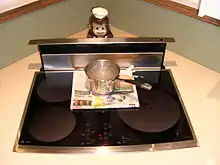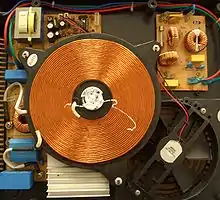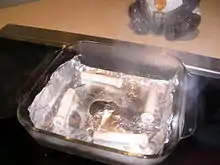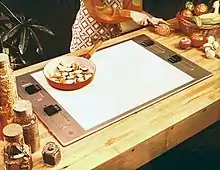Induction cooking
Induction cooking is performed using direct induction heating of cooking vessels, rather than relying on indirect radiation, convection, or thermal conduction. Induction cooking allows high power and very rapid increases in temperature to be achieved, and changes in heat settings are instantaneous.[1]

In an induction cooktop ("induction hob" or "induction stove"), a coil of copper wire is placed under the cooking vessel and an alternating electric current is passed through it. The resulting oscillating magnetic field wirelessly induces an electrical current in the vessel. This large eddy current flowing through the resistance of the vessel results in resistive heating.
For nearly all models of induction cooktops, a cooking vessel must be made of, or contain, a ferrous metal such as cast iron or some stainless steels. The iron in the pot concentrates the current to produce heat in the metal. If the metal is too thin, or does not provide enough resistance to current flow, heating will not be effective. Induction tops typically will not heat copper or aluminum vessels because the magnetic field cannot produce a concentrated current, but cast iron, enameled, carbon steel and stainless steel based pans will usually work. Any vessel can be used if placed on a suitable metal disk which functions as a conventional hotplate.
Induction cooking has good electrical coupling between the pan and the coil and is thus quite efficient, which means it puts out less waste heat and it can be quickly turned on and off. Induction has safety advantages compared to gas stoves and outputs no air pollution into the kitchen. Cooktops are also usually easy to clean, because the cooktop itself has a smooth surface and does not get very hot.
Cooking properties

Power and control
Induction cooking provides fast heating, improved thermal efficiency, and more consistent heating than cooking by thermal conduction.[2] Generally, the higher the power rating, the faster the cooking time. Induction cooktop power ratings are generally quoted for power delivered to the pan, whereas gas ratings are specified in terms of gas use, but gas is much less efficient. In practice, induction cook zones commonly have heating performance more comparable to a commercial gas burner than domestic burners.
Safety
The unit can detect whether cookware is present by monitoring power delivered. As with other electric ceramic cooking surfaces, a maximum pan size may be specified by the manufacturer, and a minimum size is also stated.
The control system shuts down the element if a pot is not present or not large enough. If a pan boils dry it can get extremely hot – a thermostat in the surface will turn off the power if it senses overheating to prevent cooker failures and potential fires.
Cooker surface
The surface of the cooker is heated only by the pot and so does not usually reach a hazardous temperature. Induction cookers are easy to clean because the cooking surface is flat and smooth and does not get hot enough to make spilled food burn and stick.
Induction cookers generally have low-thermal expansion glass ceramic tops that can be damaged by sufficient impact although they are required to meet minimum specified product safety standards with regard to impact.[3] Aluminum foil can melt onto the top and cause permanent damage or cracking of the top. Surfaces can be scratched by sliding pans across the cooking surface.
Noise
Some noise is generated by an internal cooling fan. Also, audible electromagnetically induced acoustic noise (a high pitched hum or buzz) may be produced by cookware, especially at high power, if the cookware has loose parts or if the multi-ply layers of the pot are not well bonded to each other; cookware with welded-in cladding layers and solid riveting is less likely to produce this type of noise. Some users are more capable of hearing or more sensitive to this high-frequency whine.
Other considerations
Some cooking techniques available when cooking over a flame are not applicable. Persons with implanted cardiac pacemakers or other electronic medical implants are usually instructed to avoid sources of magnetic fields; the medical literature seems to suggest that proximity to induction cooking surfaces is safe, but individuals with such implants should always check first with their cardiologists. Radio receivers near the induction-cooking unit may pick up some electromagnetic interference.
Because the cook top is shallow compared to a gas-fired or electrical coil cooking surface, wheelchair access can be improved; the user's legs can be below the counter height and the user's arms can reach over the top.
Efficiency
The 2014 ACEEE Summer Study on Energy Efficiency in Buildings concluded that "induction cooking is not always the most efficient method of cooking. When tested with a large cooking vessel, the efficiency of conventional electric technology was measured to be higher (83%) than that of induction cooking (77%). Yet the efficiency of conventional cooking appliances was shown to be highly dependent on the size of the cooking vessel."[4] Cooking methods that use flames or hot heating elements have a significantly higher loss to the ambient; induction heating directly heats the pot. Because the induction effect does not directly heat the air around the vessel, induction cooking results in further energy efficiencies. Cooling air is blown through the electronics beneath the surface but it is only slightly warm.
The purpose of a cooktop is to prepare food; for example, long periods of simmering may be required. A rational measure of efficiency would be to compare the actual energy input to the cooktop to some theoretical value required to prepare the specified food. Since experiments to make these measurements would be difficult to replicate, energy efficiency measurements that are published concentrate on the ability of a cooktop to transfer energy to a metal test block, which is much easier to measure in a repeatable fashion.
Energy transfer efficiency, as defined by U.S. Department of Energy (DOE), is the percentage of the energy consumed by a cooker that, at the end of a simulated cooking cycle, appears to have been transferred as heat to a standardized aluminum test block.
The DOE test cycle starts with both the block and the cooktop at room temperature: 77 °F ± 9 °F (25 °C ± 5 °C). The cooktop is then switched to maximum heating power. When the test block temperature reaches + 144 °F (+80 °C) above the initial room temperature, the cooktop power is immediately reduced to 25% ± 5% of its maximum power. After 15 minutes of operation at this lower power setting, the cooktop is turned off and the heat energy in the test block is measured.[5] Efficiency is given by the ratio between energy in the block and input (electric) energy.
Such a test, using a combination of two different power levels, was conceived to mimic real life use. Wasted energy terms such as residual unused heat (retained by solid hot-plates, ceramic or coil at the end of the test), and losses from convection and radiation by hot surfaces (including the ones of the block itself) are simply disregarded and don't contribute to efficiency.
In typical cooking, the energy delivered by the cooker is only partly used to heat the food up to temperature; once that has occurred, all the subsequent energy input is delivered to the air as loss through steam or convection and radiation from the pan sides. Since there is no increase in the food temperature, the DOE test procedure would consider the efficiency substantially zero. Cooking procedures such as reduction of a sauce, braising meat, simmering, and so on are significant uses of a cooker, but efficiency of these practices is not modelled by the DOE test procedure.
In 2013 and 2014 DOE developed and proposed new test procedures for cooking products to allow direct comparison of energy transfer efficiency measurements among induction, electric resistance, and gas cooking tops and ranges. The procedures use a new hybrid test block made of aluminum and stainless steel, so it is suitable for tests on induction cookers. The proposed rule lists results of real lab tests conducted with the hybrid block. For comparable (large) cooking elements the following efficiencies were measured with ±0.5% repeatability: 70.7% - 73.6% for induction, 71.9% for electric coil, 43.9% for gas. Summarizing the results of several tests, DOE affirms that "induction units have an average efficiency of 72.2%, not significantly higher than the 69.9% efficiency of smooth—electric resistance units, or the 71.2% of electric coil units".[6] Moreover, DOE reminds that the 84% induction efficiency, cited in previous Technical Support Documents, was not measured by DOE laboratories but just "referenced from an external test study" performed in 1992.[6]
In addition independent tests conducted by manufacturers,[7] research laboratories[1] and other subjects seem to demonstrate that actual induction cooking efficiencies stays usually between 74% and 77% and reach occasionally 81% (although these tests could follow procedures different from that of DOE). These clues indicate that the 84% induction average efficiency reference value should be taken with caution.
Just for comparison and in agreement with DOE findings, cooking with gas has an average energy efficiency of about 40%. It can be raised only by using special pots with fins whose first design and commercialization came years ago,[8] but that have been recently rediscovered, redesigned in a different way and put again on the market.[9] So for environmental considerations dealing with induction versus gas, a 40% gas efficiency will be used.
When comparing with gas, the relative cost of electrical and gas energy, and the efficiency of the process by which electricity is generated, affect both overall environmental efficiency[10] (as explained in more detail below) and cost to the user.
Kitchen ventilation
Energy lost from gas cooking heats the kitchen, whereas with induction cooking, the losses are much lower. This results in less heating of the kitchen itself and can affect the amount of ventilation required. In addition gas stoves are a significant source of indoor air pollution and require good ventilation.[11][12]
Gas cooking efficiencies may be lower if waste heat generation is taken into account. Especially in restaurants, gas cooking can significantly increase the ambient temperature in localized areas. Not only may extra cooling be required, but zoned venting may be needed to adequately condition hot areas without overcooling other areas. Costs must be considered on an individual situation due to numerous variables in temperature differences, facility layout or openness, and heat generation schedule. Induction cooking using grid electricity may surpass gas efficiencies when waste heat and air comfort are quantified.
In a commercial setting, induction cookers do not require safety interlocks between the fuel source and the ventilation, as may be required with gas systems.
Design


An induction cooker transfers electrical energy by induction from a coil of wire into a metal vessel that must be ferromagnetic. The coil is mounted under the cooking surface, and a high frequency (e.g. 24 kHz) alternating current is passed through it. The current in the coil creates a dynamic magnetic field. When an electrically conductive pot is brought close to the cooking surface, and the pan is thicker than the skin depth, the magnetic field induces large eddy currents in the pot. The eddy currents flow through the electrical resistance of the pot to produce heat through Joule heating; the pot then in turn heats its contents by heat conduction.
The cooking vessel typically needs to be made of a suitable stainless steel or iron. The increased magnetic permeability of the material decreases the skin depth, concentrating the current near the surface of the metal, and so the electrical resistance will be further increased. Some energy will be dissipated wastefully by the current flowing through the resistance of the coil. To reduce the skin effect and consequent heat generation in the coil, it is made from litz wire, which is a bundle of many smaller insulated wires in parallel. The coil has many turns, while the bottom of the pot effectively forms a single shorted turn. This forms a transformer that steps down the voltage and steps up the current. The resistance of the pot, as viewed from the primary coil, appears larger. In turn, most of the energy becomes heat in the high-resistance steel, while the driving coil stays cool.
Often a thermostat is present to measure the temperature of the pan. This helps prevent the pan from severely overheating if accidentally heated empty or boiled dry, but also can allow the induction cooker to maintain a target temperature.
Applications
Induction equipment may be a built-in surface, part of a range, or a standalone surface unit. Built-in and rangetop units typically have multiple elements, the equivalent of separate burners on a gas-fueled range. Stand-alone induction modules are usually single-element, or sometimes have dual elements. All such elements share a basic design: an electromagnet sealed beneath a heat-resisting glass-ceramic sheet that is easily cleaned. The pot is placed on the ceramic glass surface and begins to heat up, along with its contents.
In Japan, some models of rice cookers are powered by induction. In Hong Kong, power companies list a number of models. Asian manufacturers have taken the lead in producing inexpensive single-induction-zone surfaces; efficient, low-waste-heat units are advantageous in densely populated cities with little living space per family, as many Asian cities are. Induction cookers are less frequently used in other parts of the world.
Induction ranges may be applicable in commercial restaurant kitchens. Electric cooking avoids the cost of natural gas piping and in some jurisdictions may allow simpler ventilation and fire suppression equipment to be installed.[13] Drawbacks for commercial use include possible breakages of the glass cook-top, higher initial cost and the requirement for magnetic cookware.
Controls
The ferromagnetic properties of a steel vessel concentrate the induced current in a thin layer near its surface, which results in a strong heating effect. In paramagnetic materials like aluminum, the magnetic field penetrates deeper, and the induced current encounters little resistance in the metal.[14] According to Lenz's law the efficiency of the induction in the pot may be sensed, so that the induction may be attained accordingly with special electronics devices. At least one high-frequency "all-metal" cooker is available, that works with lower efficiency on non-ferromagnetic metal cookware.
The cooking surface is made of a glass-ceramic material which is a poor heat conductor, so only a little heat is lost through the bottom of the pot. In normal operation the cooking surface stays significantly cooler than with other stove cooking methods, but still needs to cool down before it can be safely touched.
Units may have one, two, three, four or five induction zones, but four (normally in a 30-inch-wide unit) is the most common in the US and Europe. Two coils are most common in Hong Kong and three are most common in Japan. Some have touch-sensitive controls. Some induction stoves have a memory setting, one per element, to control the time that heat is applied. At least one manufacturer makes a "zoneless" induction cooking surface with multiple induction coils. This allows up to five utensils to be used at once anywhere on the cooking surface, not just on pre-defined zones.[15]
Small stand-alone portable induction cookers are relatively inexpensive, priced from around US$20 in some markets.
Cookware

Cookware must be compatible with induction heating; in most models, only ferrous metal can be heated. Cookware should have a flat bottom since the magnetic field drops rapidly with distance from the surface. (Special and costly wok-shaped tops are available for use with round-bottom woks.) Induction disks are metal plates that are heated by induction and heat non-ferrous pots by thermal contact, but these are much less efficient than ferrous cooking vessels.
Induction compatible cookware for an induction cooking surface can nearly always be used on other stoves. Some cookware or packaging is marked with symbols to indicate compatibility with induction, gas, or electric heat. Induction cooking surfaces work well with any pans with a high ferrous metal content at the base. Cast iron pans and any black metal or iron pans will work on an induction cooking surface. Stainless steel pans will work on an induction cooking surface if the base of the pan is a magnetic grade of stainless steel. If a magnet sticks well to the sole of the pan, it will work on an induction cooking surface. An "all-metal" cooker will work with non-ferrous cookware, but available models are limited.
Aluminum or copper alone does not work on other induction cooktops because of the materials’ magnetic and electrical properties.[16] Aluminum and copper cookware are more conductive than steel, but the skin depth in these materials is larger since they are non-magnetic. The current flows in a thicker layer in the metal, encounters less resistance and so produces less heat. Ordinary induction cookers will not work efficiently with such pots. However, aluminum and copper are desirable in cookware, since they conduct heat better. Because of this 'tri-ply' pans often have an induction-compatible skin of stainless steel containing a layer of thermally conductive aluminum.
For frying, a pan with a base that is a good heat conductor is needed to spread the heat quickly and evenly. The sole of the pan will be either a steel plate pressed into the aluminum, or a layer of stainless steel over the aluminum. The high thermal conductivity of aluminum pans makes the temperature more uniform across the pan. Stainless frying pans with an aluminum base will not have the same temperature at their sides as an aluminum sided pan will have. Cast iron frying pans work well with induction cooking surfaces but the material is not as good a thermal conductor as aluminum.
When boiling water, the circulating water spreads the heat and prevents hot spots. For products such as sauces, it is important that at least the base of the pan incorporates a good heat conducting material to spread the heat evenly. For delicate products such as thick sauces, a pan with aluminum throughout is better, since the heat flows up the sides through the aluminum, allowing the cook to heat the sauce rapidly but evenly.

The heat that can be produced in a pot is a function of the surface resistance. A higher surface resistance produces more heat for similar currents. This is a “figure of merit” that can be used to rank the suitability of a material for induction heating. The surface resistance in a thick metal conductor is proportional to the resistivity divided by the skin depth. Where the thickness is less than the skin depth, the actual thickness can be used to calculate surface resistance.[16] Some common materials are listed in this table.
| Material | Resistivity (10−6 ohm-inches) |
Relative permeability |
Skin depth, inches (mm) |
Surface resistance, 10−3 ohms/square (thick material) |
Surface resistance, relative to copper |
|---|---|---|---|---|---|
| Carbon steel 1010 | 9 | 200 | 0.004 (0.10) | 2.25 | 56.25 |
| Stainless steel 432 | 24.5 | 200 | 0.007 (0.18) | 3.5 | 87.5 |
| Stainless steel 304 | 29 | 1 | 0.112 (2.8) | 0.26 | 6.5 |
| Aluminum | 1.12 | 1 | 0.022 (0.56) | 0.051 | 1.28 |
| Copper | 0.68 | 1 | 0.017 (0.43) | 0.04 | 1 |
To get the same surface resistance as with carbon steel would require the metal to be thinner than is practical for a cooking vessel; at 24 kHz a copper vessel bottom would need to be 1/56th the skin depth of carbon steel. Since the skin depth is inversely proportional to the square root of the frequency, this suggests that much higher frequencies would be required to obtain equivalent heating in a copper pot as in an iron pot at 24 kHz. Such high frequencies are not feasible with inexpensive power semiconductors; in 1973 the silicon-controlled rectifiers used were limited to no more than 40 kHz.[16] Even a thin layer of copper on the bottom of a steel cooking vessel will shield the steel from the magnetic field and make it unusable for an induction top.[16] Some additional heat is created by hysteresis losses in the pot due to its ferromagnetic nature, but this creates less than ten percent of the total heat generated.[17]
"All-metal" models
New types of power semiconductors and low-loss coil designs have made an all-metal cooker possible.
Panasonic Corporation in 2009 developed a consumer induction cooker that uses a higher-frequency magnetic field, and a different oscillator circuit design, to allow use with non-ferrous metals.[18][19] In 2017 Panasonic released a single-burner counter top "all metal" unit, using their trade name "Met-All", aimed at commercial kitchens.[20]
History
.jpg.webp)
First patents date from the early 1900s.[21] Demonstration stoves were shown by the Frigidaire division of General Motors in the mid-1950s[22] on a touring GM showcase in North America. The induction cooker was shown heating a pot of water with a newspaper placed between the stove and the pot, to demonstrate the convenience and safety. This unit, however, was never put into production.
Modern implementation in the USA dates from the early 1970s, with work done at the Research & Development Center of Westinghouse Electric Corporation at Churchill Borough, near Pittsburgh,[16] That work was first put on public display at the 1971 National Association of Home Builders convention in Houston, Texas, as part of the Westinghouse Consumer Products Division display. The stand-alone single-burner range was named the Cool Top Induction Range. It used paralleled Delco Electronics transistors developed for automotive electronic ignition systems to drive the 25 kHz current.

Westinghouse decided to make a few hundred production units to develop the market. Those were named Cool Top 2 (CT2) Induction ranges. The development work was done at the same R&D location by a team led by Bill Moreland and Terry Malarkey. The ranges were priced at $1,500 ($8,260 in 2017 dollars), including a set of high quality cookware made of Quadraply, a new laminate of stainless steel, carbon steel, aluminum and another layer of stainless steel (outside to inside).
Production took place in 1973 through to 1975 and stopped, coincidentally, with the sale of Westinghouse Consumer Products Division to White Consolidated Industries Inc.
CT2 had four "burners" of about 1,600 watts each, measured by calorimetry. The range top was a Pyroceram ceramic sheet surrounded by a stainless-steel bezel, upon which four magnetic sliders adjusted four corresponding potentiometers set below. That design, using no through-holes, made the range impervious to spills. The electronics section was made of four identical modules which were cooled by a single quiet, low-speed, high-torque fan.
In each of the electronics modules, the 240 V, 60 Hz domestic line power was converted to between 20 V to 200 V of continuously variable DC by a phase-controlled rectifier. That DC power was in turn converted to 27 kHz 30 A (peak) AC by two arrays of six paralleled Motorola automotive-ignition transistors in a half-bridge configuration driving a series-resonant LC oscillator, of which the inductor component was the induction-heating coil and its load, the cooking pan. The circuit design, largely by Ray Mackenzie,[23] successfully dealt with certain bothersome overload problems.
Control electronics included functions such as protection against over-heated cook-pans and overloads. Provision was made to reduce radiated electrical and magnetic fields.[24][25] There was also magnetic pan detection.[26]
CT2 was UL Listed and received Federal Communications Commission (FCC) approval, both firsts. Numerous patents were also issued. CT2 won several awards, including Industrial Research Magazine's IR-100 1972 best-product award [27] and a citation from the United States Steel Association. Raymond Baxter demonstrated the CT2 on the BBC series Tomorrow's World. He showed how the CT2 could cook through a slab of ice.
Sears Kenmore sold a free-standing oven/stove with four induction-cooking surfaces in the mid-1980s (Model Number 103.9647910). The unit also featured a self-cleaning oven, solid-state kitchen timer and capacitive-touch control buttons (advanced for its time). The units were more expensive than standard cooking surfaces.
In 2009 Panasonic developed an all-metal induction cooker that used frequencies up to 120 kHz,[28] three to five times higher than other cooktops, to work with non-ferrous metal cookware.
Vendors
The market for induction stoves is dominated by German manufacturers.
Single ring portable hobs have become popular in the UK, with prices as low as £30 from discounters.
The European induction cooking market for hotels, restaurants and other caterers is primarily satisfied by smaller specialist commercial induction catering equipment manufacturers.
Taiwanese and Japanese electronics companies are the dominant players in induction cooking for East Asia. After aggressive promotions by utilities in HK, many local brands emerged. Their power and ratings are high, more than 2,800 watts. Some of these companies have also started marketing in the West. However, the product range sold in Western markets is a subset of that in their domestic market; some Japanese electronics manufacturers only sell domestically.
In the United States, as of early 2013 there are over five dozen brands of induction-cooking equipment available, including both built-in and countertop residential equipment and commercial-grade equipment. Even restricting to built-in residential-use units, there are over two dozen brands being sold; residential countertop units add another two-dozen-plus brands to the count.
The National Association of Home Builders in 2012 estimated that, in the United States, induction cooktops held only 4% of sales, compared to gas and other electric cooktops.[29] The global induction cooktops market was estimated at $9.16 ml in value during 2015 and is set to grow to $13.53 mil by 2022.
In April 2010, The New York Times reported that "In an independent survey last summer by the market research company Mintel of 2,000 Internet users who own appliances, only 5 percent of respondents said they had an induction range or cooktop. . . . Still, 22 percent of the people Mintel surveyed in connection to their study last summer said their next range or cooktop would be induction."[30]
References
- "Induction Cooking Technology Design and Assessment; M. Sweeney, J. Dols, B. Fortenbery, F. Sharp; Electric Power Research Institute (EPRI)" (PDF). Archived from the original (PDF) on 2015-09-10. Retrieved 2016-09-19. Paper presented at the 2014 ACEEE Summer Study on Energy Efficiency in Buildings
- Agbinya, Johnson I. (2015-12-01). Wireless Power Transfer. ISBN 9788793237629.
- Hans Bach, Dieter Krause, Low thermal expansion glass ceramics, Springer, 2005 ISBN 3-540-24111-6 page 77, lists IEC, UL, Canadian, Australian and other standards with impact resistance requirements
- https://aceee.org/files/proceedings/2014/data/papers/9-702.pdf
- "Code of Federal Regulations, Title 10, Chapter II, Subchapter D, Part 430, Subpart B, Appendix I: Uniform test method for measuring the energy consumption of conventional ranges, conventional cooking tops, conventional ovens, and microwave ovens" (PDF). Retrieved 2016-09-15.
- "Federal Register, Vol. 79 No. 232, December 3 2014, Part III, Department of Energy, Energy Conservation Program: Test Procedures for Conventional Cooking Products; Proposed Rule" (PDF). Retrieved 2016-03-14.
- "Electrolux sustainability" (PDF). Archived from the original (pdf) on 2016-09-19. Retrieved 2016-09-19. See slide # 57
- Greg Sorensen; David Zabrowski (August 2009). "Improving Range-Top Efficiency with Specialized Vessels". Appliance Magazine. Archived from the original on July 7, 2011. Retrieved 2010-08-07.
- "Oxford-designed Flare pan uses 40 per cent less heat than conventional pans — Department of Engineering Science — University of Oxford". Archived from the original on 2016-09-28. Retrieved 2016-09-17.
- Shopping guide to Gas & Electric Cookers, Ovens & Hobs, from Ethical Consumer. "The low CO2 choice is pretty much always gas, where it is available. Although gas ovens and hobs use more energy, gas generates less carbon dioxide per kWh."
- https://www.theatlantic.com/science/archive/2020/10/gas-stoves-are-bad-you-and-environment/616700/?utm_source=pocket-newtab-global-en-GB
- https://rmi.org/insight/gas-stoves-pollution-health/
- Roger Fields, Restaurant Success by the Numbers: A Money-Guy's Guide to Opening the Next Hot Spot, Random House of Canada, 2007 ISBN 1-58008-663-2, pp. 144–145
- Llorente, S.; Monterde, F.; Burdio, J.M.; Acero, J. (2002). "A comparative study of resonant inverter topologies used in induction cookers". APEC. Seventeenth Annual IEEE Applied Power Electronics Conference and Exposition (Cat. No.02CH37335). 2. pp. 1168–1174. doi:10.1109/APEC.2002.989392. ISBN 978-0-7803-7404-1. S2CID 110793517.
- DeDietrich "Piano" cooktop specifications, retrieved 2012 May 9 Archived 2014-05-02 at the Wayback Machine, dedietrich.co.uk
- W. C. Moreland, The Induction Range: Its Performance and Its Development Problems, IEEE Transactions on Industry Applications, vol. TA-9, no. 1, January/February 1973 pages 81–86
- Fairchild Semiconductors (July 2000). "AN9012 Induction Heating System Topology Review" (PDF). Archived from the original (PDF) on 2014-07-24. Retrieved 2009-05-20.
- Fujita, Atsushi; Sadakata, Hideki; Hirota, Izuo; Omori, Hideki; Nakaoka, Mutsuo (17–20 May 2009). Latest developments of high-frequency series load resonant inverter type built-in cooktops for induction heated all metallic appliances. Power Electronics and Motion Control Conference, 2009. IPEMC '09. IEEE 6th International. pp. 2537–2544. doi:10.1109/IPEMC.2009.5157832. ISBN 978-1-4244-3557-9.
- Tanuki Soup (9 October 2010). "Big news for fans of induction cooktops". Chow. Retrieved 28 March 2013.
- "Panasonic Introduces Groundbreaking New Induction Cooktop, Providing Extraordinary Commercial Cooking Performance with All Kinds of Metal Cookware". shop.panasonic.com.
- for example see UK Patent Application GB190612333, entitled "Improvements in or relating to Apparatus for the Electrical Production of Heat for Cooking and other purposes", applied for by Arthur F. Berry on 26 May 1906
- Kitchen of the Future has Glass-Dome Oven and Automatic Food Mixer, Popular Mechanics Apr 1956, page 88
- Induction Heat Cooking Apparatus
- Cooking vessel capacitive decoupling for induction cooking apparatus
- Induction heating coil assembly for heating cooking vessels
- Pan detector for induction heating cooking unit
- Archive, retrieved 2012 Aug 22, rdmag.com
- https://www.sefa.com/panasonic-takes-induction-next-level/ "Panasonic takes induction to the next level", retrieved September 19, 2018
- Kitchen Appliance Upgrades that Shine, retrieved 2012 Aug 15, nahb.org
- Is Induction Cooking Ready to Go Mainstream? , retrieved 2013 Jan 31, nytimes.com
External links
| Wikimedia Commons has media related to Induction cookers. |